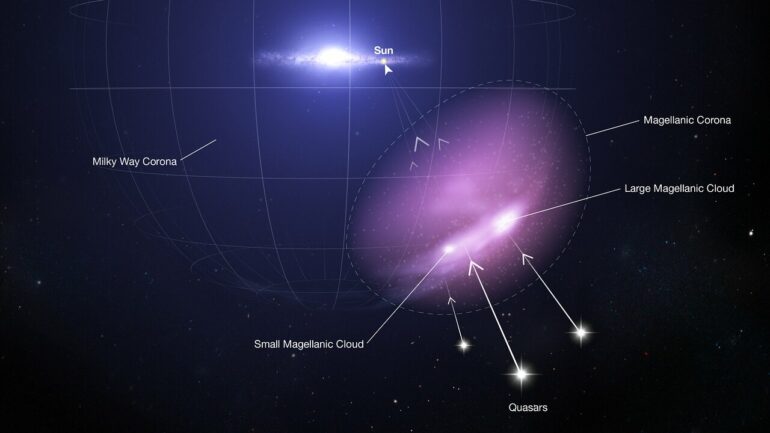For billions of years, the Milky Way’s largest satellite galaxies—the Large and Small Magellanic Clouds—have followed a perilous journey. Orbiting one another as they are pulled in toward our home galaxy, they have begun to unravel, leaving behind trails of gaseous debris. And yet—to the puzzlement of astronomers—these dwarf galaxies remain intact, with ongoing vigorous star formation.
“A lot of people were struggling to explain how these streams of material could be there,” said Dhanesh Krishnarao, assistant professor at Colorado College. “If this gas was removed from these galaxies, how are they still forming stars?”
With the help of data from NASA’s Hubble Space Telescope and a retired satellite called the Far Ultraviolet Spectroscopic Explorer (FUSE), a team of astronomers led by Krishnarao has finally found the answer: the Magellanic system is surrounded by a corona, a protective shield of hot supercharged gas. This cocoons the two galaxies, preventing their gas supplies from being siphoned off by the Milky Way, and therefore allowing them to continue forming new stars.
This discovery, which was just published in Nature, addresses a novel aspect of galaxy evolution. “Galaxies envelope themselves in gaseous cocoons, which act as defensive shields against other galaxies,” said co-investigator Andrew Fox of the Space Telescope Science Institute in Baltimore, Maryland.
Astronomers predicted the corona’s existence several years ago. “We discovered that if we included a corona in the simulations of the Magellanic Clouds falling onto the Milky Way, we could explain the mass of extracted gas for the first time,” explained Elena D’Onghia, a co-investigator at the University of Wisconsin–Madison. “We knew that the Large Magellanic Cloud should be massive enough to have a corona.”
But although the corona stretches more than 100,000 light-years from the Magellanic clouds and covers a huge portion of the southern sky, it is effectively invisible. Mapping it required scouring through 30 years of archived data for suitable measurements.
Researchers think that a galaxy’s corona is a remnant of the primordial cloud of gas that collapsed to form the galaxy billions of years ago. Although coronas have been seen around more distant dwarf galaxies, astronomers had never before been able to probe one in as much detail as this.
“There’re lots of predictions from computer simulations about what they should look like, how they should interact over billions of years, but observationally we can’t really test most of them because dwarf galaxies are typically just too hard to detect,” said Krishnarao. Because they are right on our doorstep, the Magellanic Clouds provide an ideal opportunity to study how dwarf galaxies interact and evolve.
In search of direct evidence of the Magellanic Corona, the team combed through the Hubble and FUSE archives for ultraviolet observations of quasars located billions of light-years behind it. Quasars are the extremely bright cores of galaxies harboring massive active black holes. The team reasoned that although the corona would be too dim to see on its own, it should be visible as a sort of fog obscuring and absorbing distinct patterns of bright light from quasars in the background. Hubble observations of quasars were used in the past to map the corona surrounding the Andromeda galaxy.
By analyzing patterns in ultraviolet light from 28 quasars, the team was able to detect and characterize the material surrounding the Large Magellanic Cloud and confirm that the corona exists. As predicted, the quasar spectra are imprinted with the distinct signatures of carbon, oxygen, and silicon that make up the halo of hot plasma that surrounds the galaxy.
The ability to detect the corona required extremely detailed ultraviolet spectra. “The resolution of Hubble and FUSE were crucial for this study,” explained Krishnarao. “The corona gas is so diffuse, it’s barely even there.” In addition, it is mixed with other gases, including the streams pulled from the Magellanic Clouds and material originating in the Milky Way.
By mapping the results, the team also discovered that the amount of gas decreases with distance from the center of the Large Magellanic Cloud. “It’s a perfect telltale signature that this corona is really there,” said Krishnarao. “It really is cocooning the galaxy and protecting it.”
How can such a thin shroud of gas protect a galaxy from destruction?
“Anything that tries to pass into the galaxy has to pass through this material first, so it can absorb some of that impact,” explained Krishnarao. “In addition, the corona is the first material that can be extracted. While giving up a little bit of the corona, you’re protecting the gas that’s inside the galaxy itself and able to form new stars.”
More information:
Dhanesh Krishnarao et al, Observations of a Magellanic Corona, Nature (2022). DOI: 10.1038/s41586-022-05090-5
Citation:
Hubble detects protective shield defending a pair of dwarf galaxies (2022, September 28)
